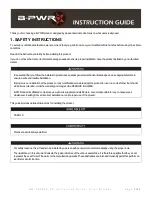
4
Colorado Motorcycle Operator’s Handbook
HELMET SELECTIONS: There are two primary types of
helmets, providing two different levels of coverage, three-
quarter and full face.
Whichever style you choose, you can receive the most
protection out of that type helmet by making sure it meets
U.S. Department of Transportation (DOT) standards. Hel-
mets with labels from the American National Standards
Institute (ANSI), or the Snell Memorial Foundation give
\RXDGGHGDVVXUDQFHRITXDOLW\,WVKRXOGÀWVQXJO\DOOWKH
way around and have no obvious defects such as cracks,
loose padding, or frayed straps.
Whatever helmet you decide on, make sure to keep it
securely fastened on your head when you ride. Otherwise,
LI\RXDUHLQYROYHGLQDFUDVKWKHKHOPHWLVOLNHO\WRÁ\RII
your head before it has a chance to protect you.
EYE AND FACE PROTECTION: A plastic face shield can
help protect your whole face in a crash. The helmet also
protects you from wind, dust, dirt, rain, insects, and stones
thrown up from cars ahead.
Goggles protect your eyes, but they won’t protect the rest
of your face the way a face shield does. A windshield is no
substitute for a face shield or goggles. Most windshields
will not protect your eyes from wind.
Tinted eye protection should not be worn at night or any
other time when little light is available.
To be effective, eye or face shield protection must:
%HIUHHRIVFUDWFKHV
%HPDGHRIVKDWWHUSURRIPDWHULDO
*LYHDFOHDUYLHZWRHLWKHUVLGH
)DVWHQVHFXUHO\VRLWGRHVQRWEORZRII
$OORZDLUWRSDVVWKURXJKWRUHGXFHIRJJLQJ
$OORZHQRXJKURRPIRUH\HJODVVHVVXQJODVVHVLI
needed.
E Y E P R O T E C T I O N F O R M O T O R C Y C L E
OPERATORS AND PASSENGERS IS REQUIRED BY
COLORADO LAW
CLOTHING: Adequate clothing can help protect you in a
crash. In cold or wet weather, your clothes should keep you
warm and dry, as well as protect you from injury. You can-
not control a motorcycle well if you are numb from cold.
Riding for long periods in cold weather can cause severe
chill and fatigue. A winter jacket should resist wind and
ÀWVQXJO\DWWKHQHFNZULVWVDQGZDLVW*RRGTXDOLW\UDLQ
suits designed for riding resist tearing apart or ballooning
up at high speeds.
Jacket and pants should cover your arms and legs com-
SOHWHO\7KH\VKRXOGÀWVQXJO\\HWORRVHO\HQRXJKWRPRYH
freely. Leather offers the most protection, but heavy denim
does an adequate job in most cases. Sturdy synthetic mate-
rial provides a lot of protection as well. Wear a jacket even
in warm weather. Many jackets are designed to protect you
without getting you overheated, even on summer days.
Boots or shoes should be high enough to cover your ankles
and sturdy enough to give them support. Soles should be
made of hard, durable material. Heels should be short, so
they do not catch on rough surfaces. Tuck laces in so they
won’t catch on your motorcycle.
Gloves give you a better grip and help protect your hands
in a crash. Your gloves should be made of leather or heavy
cloth.
2.2 CHECK THE MOTORCYCLE
: Make a complete
check of your motorcycle before you ride.
TIRES: Check the air pressure.
FLUIDS: Oil and fuel levels. Look under the motorcycle
for signs of oil and gas leaks.
HEADLIGHT AND TAILLIGHT: Test your dimmer
switch to make sure both high and low beams are working.
TURN SIGNALS: Turn on both right and left turn signals.
0DNHVXUHDOOIRXUOLJKWVÁDVK
BRAKE LIGHT: Try both controls and make sure each one
turns on the brake light.
CLUTCH AND THROTTLE: Make sure they work
smoothly. The throttle should snap back when you let go.
MIRRORS: Clean and adjust both mirrors before starting
out.
BRAKES: Try the front and rear brake one at a time. Make
VXUHHDFKRQHIHHOVÀUPDQGKROGVWKHPRWRUF\FOHZKHQ
the brake is fully applied.
HORN: Make sure the horn works.
2.3 BECOME FAMILIAR WITH THE MOTORCYCLE:
Make sure you are completely familiar with the motor-
cycle before you take it out on the street. Over half the
motorcycle accidents occur to riders with less than six
months experience on the cycle. If you are going to use
an unfamiliar motorcycle:






































